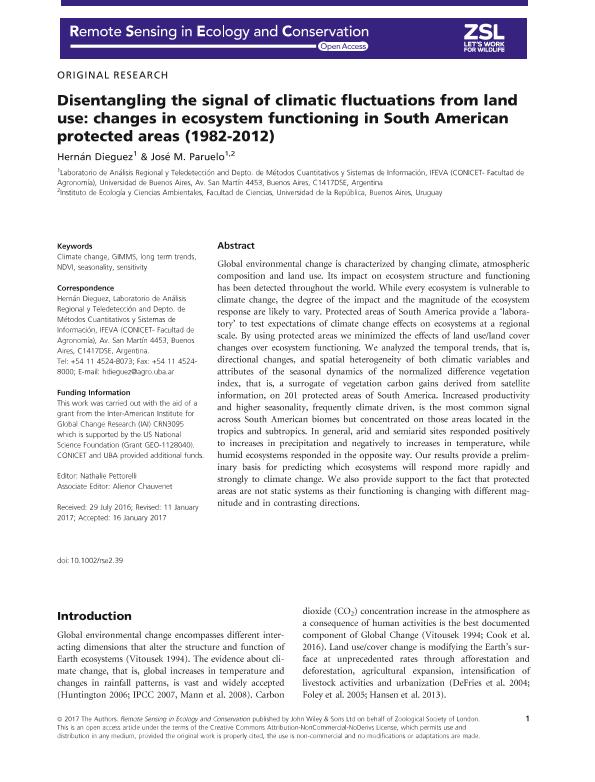Mostrar el registro sencillo del ítem
dc.contributor.author
Dieguez, Hernan Dario

dc.contributor.author
Paruelo, José

dc.date.available
2018-07-03T16:20:40Z
dc.date.issued
2017-12
dc.identifier.citation
Dieguez, Hernan Dario; Paruelo, José; Disentangling the signal of climatic fluctuations from land use: changes in ecosystem functioning in South American protected areas (1982-2012); John Wiley & Sons Ltd; Remote Sensing in Ecology and Conservation; 3; 4; 12-2017; 177-189
dc.identifier.uri
http://hdl.handle.net/11336/51035
dc.description.abstract
Global environmental change is characterized by changing climate, atmospheric composition and land use. Its impact on ecosystem structure and functioning has been detected throughout the world. While every ecosystem is vulnerable to climate change, the degree of the impact and the magnitude of the ecosystem response are likely to vary. Protected areas of South America provide a ‘laboratory’ to test expectations of climate change effects on ecosystems at a regional scale. By using protected areas we minimized the effects of land use/land cover changes over ecosystem functioning. We analyzed the temporal trends, that is, directional changes, and spatial heterogeneity of both climatic variables and attributes of the seasonal dynamics of the normalized difference vegetation index, that is, a surrogate of vegetation carbon gains derived from satellite information, on 201 protected areas of South America. Increased productivity and higher seasonality, frequently climate driven, is the most common signal across South American biomes but concentrated on those areas located in the tropics and subtropics. In general, arid and semiarid sites responded positively to increases in precipitation and negatively to increases in temperature, while humid ecosystems responded in the opposite way. Our results provide a preliminary basis for predicting which ecosystems will respond more rapidly and strongly to climate change. We also provide support to the fact that protected areas are not static systems as their functioning is changing with different magnitude and in contrasting directions.
dc.format
application/pdf
dc.language.iso
eng
dc.publisher
John Wiley & Sons Ltd

dc.rights
info:eu-repo/semantics/openAccess
dc.rights.uri
https://creativecommons.org/licenses/by-nc-nd/2.5/ar/
dc.subject
Climate Change
dc.subject
Gimms
dc.subject
Long Term Trends
dc.subject
Seasonality
dc.subject
Sensitivity
dc.subject
Ndvi
dc.subject.classification
Meteorología y Ciencias Atmosféricas

dc.subject.classification
Ciencias de la Tierra y relacionadas con el Medio Ambiente

dc.subject.classification
CIENCIAS NATURALES Y EXACTAS

dc.title
Disentangling the signal of climatic fluctuations from land use: changes in ecosystem functioning in South American protected areas (1982-2012)
dc.type
info:eu-repo/semantics/article
dc.type
info:ar-repo/semantics/artículo
dc.type
info:eu-repo/semantics/publishedVersion
dc.date.updated
2018-06-19T15:52:17Z
dc.identifier.eissn
2056-3485
dc.journal.volume
3
dc.journal.number
4
dc.journal.pagination
177-189
dc.journal.pais
Reino Unido

dc.journal.ciudad
Londres
dc.description.fil
Fil: Dieguez, Hernan Dario. Consejo Nacional de Investigaciones Científicas y Técnicas. Oficina de Coordinación Administrativa Parque Centenario. Instituto de Investigaciones Fisiológicas y Ecológicas Vinculadas a la Agricultura. Universidad de Buenos Aires. Facultad de Agronomía. Instituto de Investigaciones Fisiológicas y Ecológicas Vinculadas a la Agricultura; Argentina. Universidad de Buenos Aires. Facultad de Agronomía. Departamento de Métodos Cuantitativos y Sistemas de Información; Argentina
dc.description.fil
Fil: Paruelo, José. Consejo Nacional de Investigaciones Científicas y Técnicas. Oficina de Coordinación Administrativa Parque Centenario. Instituto de Investigaciones Fisiológicas y Ecológicas Vinculadas a la Agricultura. Universidad de Buenos Aires. Facultad de Agronomía. Instituto de Investigaciones Fisiológicas y Ecológicas Vinculadas a la Agricultura; Argentina. Universidad de Buenos Aires. Facultad de Agronomía. Departamento de Métodos Cuantitativos y Sistemas de Información; Argentina. Universidad de la República; Uruguay
dc.journal.title
Remote Sensing in Ecology and Conservation
dc.relation.alternativeid
info:eu-repo/semantics/altIdentifier/doi/http://dx.doi.org/10.1002/rse2.39
dc.relation.alternativeid
info:eu-repo/semantics/altIdentifier/url/https://zslpublications.onlinelibrary.wiley.com/doi/full/10.1002/rse2.39
Archivos asociados
